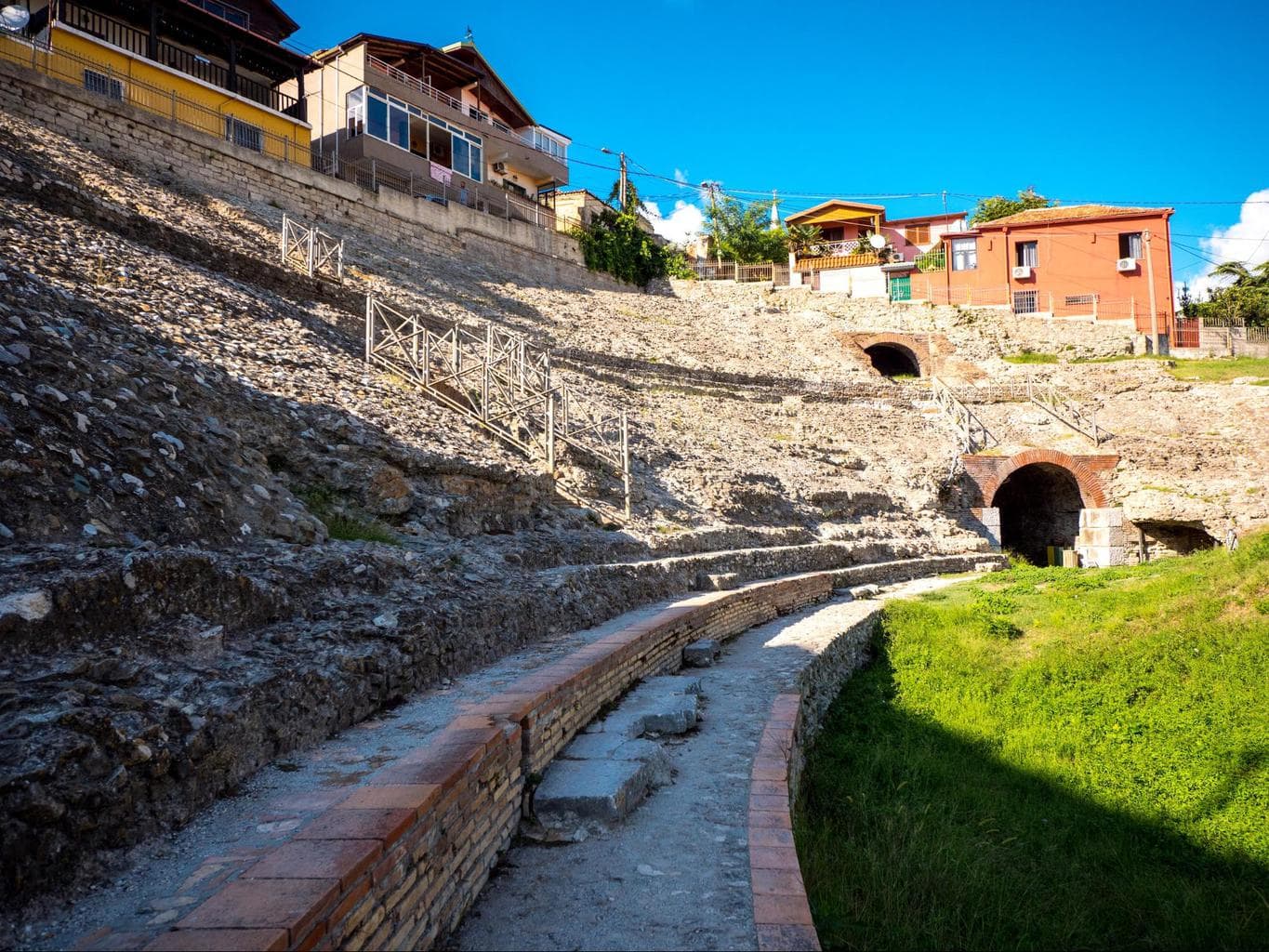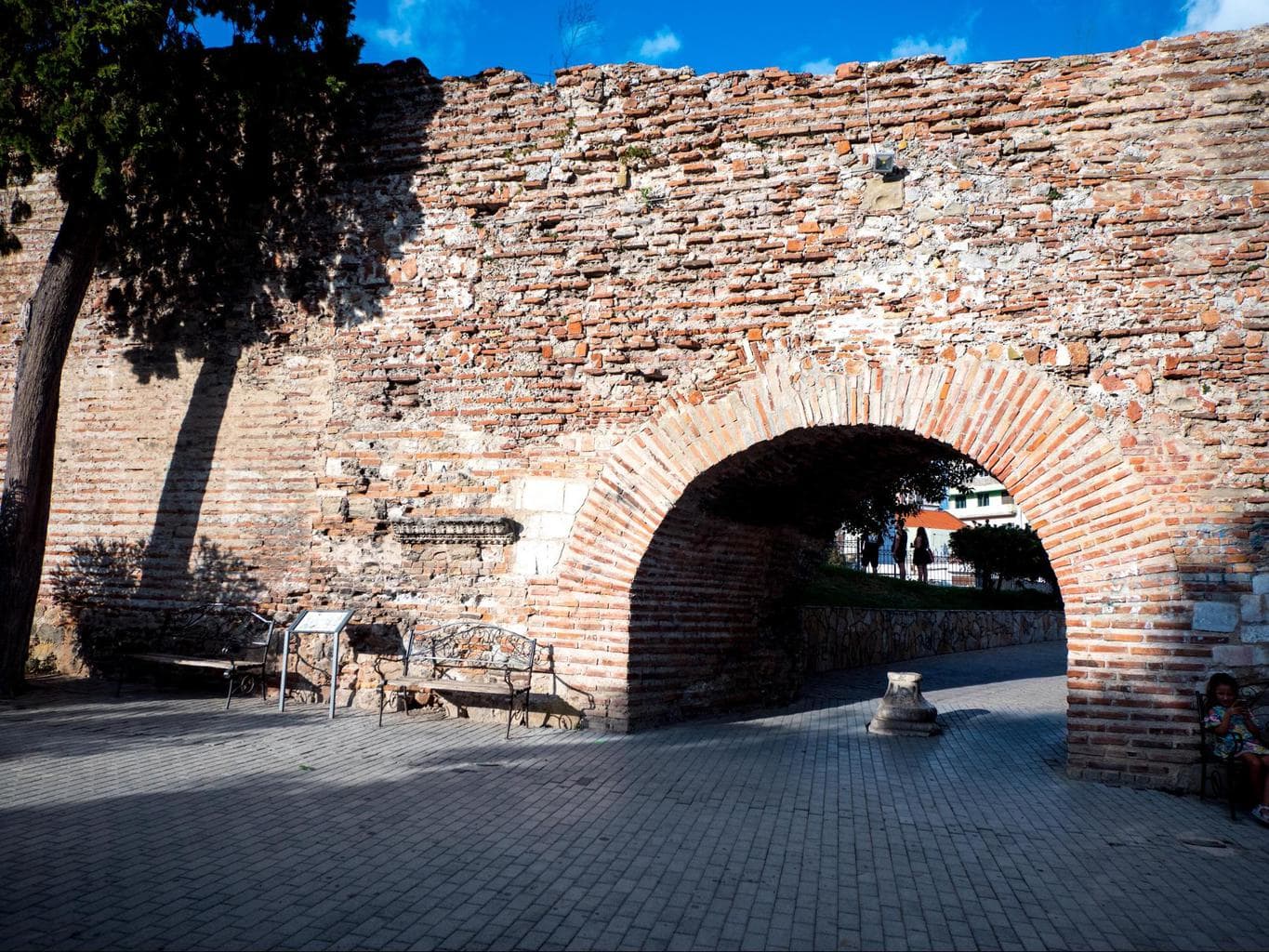Durres is about an hour’s drive from Tirana and also the closest beach from the capital. But besides the long stretch of beach, the coastal city also has a rich past with several Roman remains and other ancient constructions that can be visited.
After spending a few days in Tirana, visiting Durres is one of the easiest and most interesting things to do in Albania. Durres was an important ancient port and was first founded by the Greek in the 7th century BC. It then became part of the Roman Empire in the 3rd century BC and it grew and expanded as a key naval and military base.
After the city walls were destroyed in an earthquake in the 4th century, they were rebuilt thicker than ever and subsequently rebuilt several more times and some parts still stand today. When the Western Roman Empire fell, the city continued under Byzantine rule.
The Middle Ages brought a lot of instability to Durres and while the city continued to be an important strategic enclave, this only meant it was attacked by pretty much anyone, from nobles to Slavs, Venetians, Albanians, and eventually, the Ottomans who gained control of Durres in the 16th century.
Under Ottoman rule the city declined and lost its population and its earlier importance. Sadly, a lot of the original Roman, Venetian and Ottoman constructions were left to time and have yet to be fully restored so visiting Durres is like going back in time.
Outside weekends and summer months, the city center is very quiet, and you might find yourself alone inside the main sights, even in early September we were the only ones.
There are also tours of Durres that come with a professional guide so you can explore the ancient sites with a knowledgable informant. Depending on how much time you have to spare, you can either go on a 5 hour guided tour or a 10 hour guided tour that also includes a delicious wine tasting.
Looking for an online guide on what to see in Durres? Let’s take a look at one of the most interesting cities to visit in Albania. And then go on exploring the rest of the continent in this epic European Road Trip Guide.
Roman Amphitheatre of Durres
The 2th century Roman Amphitheatre of Durres is perhaps the city’s most notable of all the tourist attractions and the largest in the Balkans. It has also been submitted for inclusion into Albania’s UNESCO site list.
Together with Apollonia and Butrint, this is one of the oldest constructions in the country but also one of the more recently discovered.
While there are amphitheatres and theatres in lots of places around the world, for example in Tarragona which is an easy day trip from Barcelona, the one in Durres is interesting because of its location right in the middle of the city, surrounded by apartment blocks. This is because it was only discovered in 1966 by archeologist Vangjel Toci.
The amphitheatre is compared to the most famous ones of antiquity and was built in an elliptical shape measuring more than 120m long and accommodating between 15,000 and 18,000 spectators.
The theatre, like all the others of the time, was used to showcase gladiator and slave tournaments between themselves and against beasts. Spectators would sit in the audience and watch the gruesome fights to death.
Without any risk to your life, today you can pay a ticket entrance and then walk underneath the half of the structure that remains above the ground and has been excavated. A part of the amphitheatre is underground, covered in layers of soil, and about half has not survived the passing of time and crumbled into oblivion.
One of the most interesting things to see in Durres are the remains of mosaic murals that have been preserved and are behind locked bars. They depict saints and angels. These were part of a 5th century AD church which was built to host Christian ceremonies.
The walls of Durres
Outside the amphitheatre you can’t miss a visit to the Durres Castle also referred to as the Durres walls or Byzantine walls, which surround the city and you will most likely have to pass under on your way to the ampitheatre.
These walls were erected when the city was founded and were expanded as it grew. Today’s walls were built during the Byzantine rule in the 5th and 6th century AD after the 4th century earthquake.
The walls were originally a row of three and had a perimeter of 3.5km, were 3.5m thick and a height of 18m. When the city fell into Ottoman control in the 16th century the walls and the entire city were reduced significantly to a sixth of its Byzantine size. Two entrances to the castle were left, the Sea Gate and the Great Gate.
The Venetian Tower
Part of the walls are the remains of a large Venetian Tower which stands 9m tall and wide at one corner near the beach. The walls originally had square towers every 60m but the existing tower was built during the Venetian Republic and is round with walls almost 4m thick.
Today, it houses a bar and restaurant called Torre Venciane with seating both on the ground floor terrace, inside as well as on top of the tower, probably the most scenic in the country.
Inside, sofas are set in the walls storage spaces that used to hold ammunition in case of attack, it’s all dim lighting and medieval atmosphere. There are also nights with live music. But the outdoor rooftop terrace is the best place. Even in the summer months, there are umbrellas for shade.
Other things to do in Durres
Durres’ rich past also means there are a lot of other things to see. Among the most important is the Durres Archaeological Museum, which is filled with all the objects discovered during the excavations in and around Durres.
You can also look out for the remains of the 5th century Byzantine forum where a few of the marble columns are still standing (you cannot get close but can only see it from outside the fence). And the 2nd century AD bathhouse which lies below the Palace of Culture.
For a break, sit at the main town square or have a drink at hip and colorful Oborri Lounge where you can relax in a shaded area under many trees in colorful cushions and nice music.
A bit removed from downtown, you can find the Royal Villa, also known as Zog’s Villa, the country’s only 20th century king. The villa is located up on a hill and it is quite a steep walk to get there, so you decide whether you prefer to drive.
The villa was used as a guest house by the Communist Regime’s Enver Hoxha and then pilfered during the civil unrest in 1977 but can still be visited.
Durres Beach
Last but not least, Durres is best known for the beach, which is long, sandy and closest to Tirana, making it one of the most popular beaches in Albania. Unlike the beautiful crystalline waters of the southern beaches in Albania, this is more of a functional escape, but still pretty popular for its proximity to the city.
Durres beach is shallow and very long, measuring almost 10km, so there is a big chance you can get a spot, although it does get incredibly crowded in the summer.
You will find all sorts of facilities here, from the omnipresent umbrellas and sun loungers, to bars and ambulant sellers offering you anything and everything under the sun, literally.
- Check if you need a visa, get help processing it at iVisa.
- Never ever leave without travel insurance. Get affordable coverage from World Nomads or long term insurance from Safety Wing.
- I find all of my flights on KAYAK. Check their Deals section too.
- Search for all your transportation between destinations on the trusted travel booking platform Bookaway.
- I book all my day trips and tours via GetYourGuide, they are the best and their tours are refundable up to 24h in advance.
- Get USD35 off your first booking with Airbnb.
- Compare hotels EVERYWHERE at HotelsCombined and book with Booking.com.
- Compare car rental prices at Rentalcars.com












